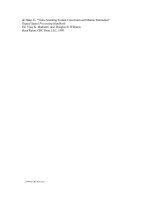Solution digital signal processing using MATLAB
Bạn đang xem bản rút gọn của tài liệu. Xem và tải ngay bản đầy đủ của tài liệu tại đây (3.03 MB, 395 trang )
Solutions Manual
for
Digital Signal Processing using Matlab - Second Edition
©Vinay K. Ingle
2007
2
Solutions Manual for DSP using Matlab (2nd Edition)
2006
Chapter 2
Discrete-Time Signals and Systems
P2.1 Generate the following sequences using the basic Matlab signal functions and the basic Matlab signal
operations discussed in this chapter. Plot signal samples using the stem function.
1. x1 (n) = 3δ(n + 2) + 2δ(n) − δ(n − 3) + 5δ(n − 7), −5 ≤ n ≤ 15
% P0201a: x1(n) = 3*delta(n + 2) + 2*delta(n) - delta(n - 3) +
%
5*delta(n - 7), -5 <= n <= 15.
clc; close all;
x1 = 3*impseq(-2,-5,15) + 2*impseq(0,-5,15) - impseq(3,-5,15) ...
+ 5*impseq(7,-5,15);
Hf_1 = figure; set(Hf_1,’NumberTitle’,’off’,’Name’,’P0201a’); n1 = [-5:15];
Hs = stem(n1,x1,’filled’); set(Hs,’markersize’,2);
axis([min(n1)-1,max(n1)+1,min(x1)-1,max(x1)+1]);
xlabel(’n’,’FontSize’,LFS); ylabel(’x_1(n)’,’FontSize’,LFS);
title(’Sequence x_1(n)’,’FontSize’,TFS);
set(gca,’XTickMode’,’manual’,’XTick’,n1,’FontSize’,8);
print -deps2 ../EPSFILES/P0201a;
The plots of x1 (n) is shown in Figure 2.1.
3
Solutions Manual for DSP using Matlab (2nd Edition)
Sequence x1(n)
6
5
4
3
x1(n)
4
2
1
0
−1
−2
−5 −4 −3 −2 −1
0
1
2
3
4
5
6
7
8
9 10 11 12 13 14 15
n
Figure 2.1: Problem P2.1.1 sequence plot
2006
2006
Solutions Manual for DSP using Matlab (2nd Edition)
5
2. x2 (n) =
k=−5
e−|k| δ(n − 2k), −10 ≤ n ≤ 10.
% P0201b: x2(n) = sum_{k = -5}^{5} e^{-|k|}*delta(n - 2k), -10 <= n <= 10
clc; close all;
n2 = [-10:10]; x2 = zeros(1,length(n2));
for k = -5:5
x2 = x2 + exp(-abs(k))*impseq(2*k ,-10,10);
end
Hf_1 = figure; set(Hf_1,’NumberTitle’,’off’,’Name’,’P0201b’);
Hs = stem(n2,x2,’filled’); set(Hs,’markersize’,2);
axis([min(n2)-1,max(n2)+1,min(x2)-1,max(x2)+1]);
xlabel(’n’,’FontSize’,LFS); ylabel(’x_2(n)’,’FontSize’,LFS);
title(’Sequence x_2(n)’,’FontSize’,TFS);
set(gca,’XTickMode’,’manual’,’XTick’,n2);
print -deps2 ../EPSFILES/P0201b;
The plots of x2 (n) is shown in Figure 2.2.
Sequence x (n)
2
2
1.5
x2(n)
1
0.5
0
−0.5
−1
−10 −9 −8 −7 −6 −5 −4 −3 −2 −1
0
1
2
3
4
5
n
Figure 2.2: Problem P2.1.2 sequence plot
6
7
8
9 10
5
Solutions Manual for DSP using Matlab (2nd Edition)
3. x3 (n) = 10u(n) − 5u(n − 5) − 10u(n − 10) + 5u(n − 15).
% P0201c: x3(n) = 10u(n) - 5u(n - 5) + 10u(n - 10) + 5u(n - 15).
clc; close all;
x3 = 10*stepseq(0,0,20) - 5*stepseq(5,0,20) - 10*stepseq(10,0,20) ...
+ 5*stepseq(15,0,20);
n3 = [0:20];
Hf_1 = figure; set(Hf_1,’NumberTitle’,’off’,’Name’,’P0201c’);
Hs = stem(n3,x3,’filled’); set(Hs,’markersize’,2);
axis([min(n3)-1,max(n3)+1,min(x3)-1,max(x3)+2]);
ytick = [-6:2:12];
xlabel(’n’,’FontSize’,LFS); ylabel(’x_3(n)’,’FontSize’,LFS);
title(’Sequence x_3(n)’,’FontSize’,TFS);
set(gca,’XTickMode’,’manual’,’XTick’,n3);
set(gca,’YTickMode’,’manual’,’YTick’,ytick);
print -deps2 ../EPSFILES/P0201c;
The plots of x3 (n) is shown in Figure 2.3.
Sequence x3(n)
12
10
8
6
x3(n)
6
4
2
0
−2
−4
−6
0
1
2
3
4
5
6
7
8
9 10 11 12 13 14 15 16 17 18 19 20
n
Figure 2.3: Problem P2.1.3 sequence plot
2006
2006
Solutions Manual for DSP using Matlab (2nd Edition)
4. x4 (n) = e0.1n [u(n + 20) − u(n − 10)].
% P0201d: x4(n) = e ^ {0.1n} [u(n + 20) - u(n - 10)].
clc; close all;
n4 = [-25:15];
x4 = exp(0.1*n4).*(stepseq(-20,-25,15) - stepseq(10,-25,15));
Hf_1 = figure; set(Hf_1,’NumberTitle’,’off’,’Name’,’P0201d’);
Hs = stem(n4,x4,’filled’); set(Hs,’markersize’,2);
axis([min(n4)-2,max(n4)+2,min(x4)-1,max(x4)+1]);
xlabel(’n’,’FontSize’,LFS); ylabel(’x_4(n)’,’FontSize’,LFS);
title(’Sequence x_4(n)’,’FontSize’,TFS); ntick = [n4(1):5:n4(end)];
set(gca,’XTickMode’,’manual’,’XTick’,ntick);
print -deps2 ../CHAP2_EPSFILES/P0201d; print -deps2 ../../Latex/P0201d;
The plots of x4 (n) is shown in Figure 2.4.
Sequence x4(n)
3
2.5
x4(n)
2
1.5
1
0.5
0
−0.5
−1
−25
−20
−15
−10
−5
0
5
n
Figure 2.4: Problem P2.1.4 sequence plot
10
15
7
Solutions Manual for DSP using Matlab (2nd Edition)
2006
5. x5 (n) = 5[cos(0.49π n) + cos(0.51π n)], −200 ≤ n ≤ 200. Comment on the waveform shape.
% P0201e: x5(n) = 5[cos(0.49*pi*n) + cos(0.51*pi*n)], -200 <= n <= 200.
clc; close all;
n5 = [-200:200]; x5
= 5*(cos(0.49*pi*n5) + cos(0.51*pi*n5));
Hf_1 = figure; set(Hf_1,’NumberTitle’,’off’,’Name’,’P0201e’);
Hs = stem(n5,x5,’filled’); set(Hs,’markersize’,2);
axis([min(n5)-10,max(n5)+10,min(x5)-2,max(x5)+2]);
xlabel(’n’,’FontSize’,LFS); ylabel(’x_5(n)’,’FOntSize’,LFS);
title(’Sequence x_5(n)’,’FontSize’,TFS);
ntick = [n5(1): 40:n5(end)]; ytick = [-12 -10:5:10 12];
set(gca,’XTickMode’,’manual’,’XTick’,ntick);
set(gca,’YTickMode’,’manual’,’YTick’,ytick);
print -deps2 ../CHAP2_EPSFILES/P0201e; print -deps2 ../../Latex/P0201e;
The plots of x5 (n) is shown in Figure 2.5.
Sequence x5(n)
12
10
5
x5(n)
8
0
−5
−10
−12
−200
−160
−120
−80
−40
0
40
80
120
n
Figure 2.5: Problem P2.1.5 sequence plot
160
200
2006
Solutions Manual for DSP using Matlab (2nd Edition)
6. x6 (n) = 2 sin(0.01π n) cos(0.5π n), −200 ≤ n ≤ 200.
%P0201f: x6(n) = 2 sin(0.01*pi*n) cos(0.5*pi*n), -200 <= n <= 200.
clc; close all;
n6 = [-200:200]; x6 = 2*sin(0.01*pi*n6).*cos(0.5*pi*n6);
Hf_1 = figure; set(Hf_1,’NumberTitle’,’off’,’Name’,’P0201f’);
Hs = stem(n6,x6,’filled’); set(Hs,’markersize’,2);
axis([min(n6)-10,max(n6)+10,min(x6)-1,max(x6)+1]);
xlabel(’n’,’FontSize’,LFS); ylabel(’x_6(n)’,’FontSize’,LFS);
title(’Sequence x_6(n)’,’FontSize’,TFS);
ntick = [n6(1): 40:n6(end)];
set(gca,’XTickMode’,’manual’,’XTick’,ntick);
print -deps2 ../CHAP2_EPSFILES/P0201f; print -deps2 ../../Latex/P0201f;
The plots of x6 (n) is shown in Figure 2.6.
Sequence x6(n)
3
2
x6(n)
1
0
−1
−2
−3
−200
−160
−120
−80
−40
0
40
80
120
n
Figure 2.6: Problem P2.1.6 sequence plot
160
200
9
Solutions Manual for DSP using Matlab (2nd Edition)
10
2006
7. x7 (n) = e−0.05n sin(0.1π n + π/3), 0 ≤ n ≤ 100.
% P0201g: x7(n) = e ^ {-0.05*n}*sin(0.1*pi*n + pi/3), 0 <= n <=100.
clc; close all;
n7 = [0:100]; x7
= exp(-0.05*n7).*sin(0.1*pi*n7 + pi/3);
Hf_1 = figure; set(Hf_1,’NumberTitle’,’off’,’Name’,’P0201g’);
Hs = stem(n7,x7,’filled’); set(Hs,’markersize’,2);
axis([min(n7)-5,max(n7)+5,min(x7)-1,max(x7)+1]);
xlabel(’n’,’FontSize’,LFS); ylabel(’x_7(n)’,’FontSize’,LFS);
title(’Sequence x_7(n)’,’FontSize’,TFS);
ntick = [n7(1): 10:n7(end)]; set(gca,’XTickMode’,’manual’,’XTick’,ntick);
print -deps2 ../CHAP2_EPSFILES/P0201g;
The plots of x7 (n) is shown in Figure 2.7.
Sequence x (n)
7
1.5
x7(n)
1
0.5
0
−0.5
−1
−1.5
0
10
20
30
40
50
60
70
80
n
Figure 2.7: Problem P2.1.7 sequence plot
90
100
2006
Solutions Manual for DSP using Matlab (2nd Edition)
8. x8 (n) = e0.01n sin(0.1π n), 0 ≤ n ≤ 100.
% P0201h: x8(n) = e ^ {0.01*n}*sin(0.1*pi*n), 0 <= n <=100.
clc; close all;
n8 = [0:100]; x8
= exp(0.01*n8).*sin(0.1*pi*n8);
Hf_1 = figure; set(Hf_1,’NumberTitle’,’off’,’Name’,’P0201h’);
Hs = stem(n8,x8,’filled’); set(Hs,’markersize’,2);
axis([min(n8)-5,max(n8)+5,min(x8)-1,max(x8)+1]);
xlabel(’n’,’FontSize’,LFS); ylabel(’x_8(n)’,’FontSize’,LFS);
title(’Sequence x_8(n)’,’FontSize’,TFS);
ntick = [n8(1): 10:n8(end)]; set(gca,’XTickMode’,’manual’,’XTick’,ntick);
print -deps2 ../CHAP2_EPSFILES/P0201h
The plots of x8 (n) is shown in Figure 2.8.
Sequence x (n)
8
3
2
x8(n)
1
0
−1
−2
−3
0
10
20
30
40
50
60
70
80
n
Figure 2.8: Problem P2.1.8 sequence plot
90
100
11
Solutions Manual for DSP using Matlab (2nd Edition)
12
2006
P2.2 Generate the following random sequences and obtain their histogram using the hist function with 100 bins.
Use the bar function to plot each histogram.
1. x1 (n) is a random sequence whose samples are independent and uniformly distributed over [0, 2] interval.
Generate 100,000 samples.
% P0202a: x1(n) = uniform[0,2]
clc; close all;
n1 = [0:100000-1]; x1 = 2*rand(1,100000);
Hf_1 = figure; set(Hf_1,’NumberTitle’,’off’,’Name’,’P0202a’);
[h1,x1out] = hist(x1,100); bar(x1out, h1);
axis([-0.1 2.1 0 1200]);
xlabel(’interval’,’FontSize’,LFS);
ylabel(’number of elements’,’FontSize’,LFS);
title(’Histogram of sequence x_1(n) in 100 bins’,’FontSize’,TFS);
print -deps2 ../CHAP2_EPSFILES/P0202a;
The plots of x1 (n) is shown in Figure 2.9.
Histogram of sequence x1(n) in 100 bins
1200
number of elements
1000
800
600
400
200
0
0
0.2
0.4
0.6
0.8
1
1.2
1.4
1.6
interval
Figure 2.9: Problem P2.2.1 sequence plot
1.8
2
2006
Solutions Manual for DSP using Matlab (2nd Edition)
13
2. x2 (n) is a Gaussian random sequence whose samples are independent with mean 10 and variance 10.
Generate 10,000 samples.
% P0202b: x2(n) = gaussian{10,10}
clc; close all;
n2 = [1:10000]; x2 = 10 + sqrt(10)*randn(1,10000);
Hf_1 = figure; set(Hf_1,’NumberTitle’,’off’,’Name’,’P0202b’);
[h2,x2out] = hist(x2,100); bar(x2out,h2);
xlabel(’interval’,’FontSize’,LFS);
ylabel(’number of elements’,’FontSize’,LFS);
title(’Histogram of sequence x_2(n) in 100 bins’,’FontSize’,TFS);
print -deps2 ../CHAP2_EPSFILES/P0202b;
The plots of x2 (n) is shown in Figure 2.10.
Histogram of sequence x (n) in 100 bins
2
400
number of elements
350
300
250
200
150
100
50
0
−5
0
5
10
15
interval
Figure 2.10: Problem P2.2.2 sequence plot
20
25
Solutions Manual for DSP using Matlab (2nd Edition)
14
2006
3. x3 (n) = x1 (n) + x1 (n − 1) where x1 (n) is the random sequence given in part 1 above. Comment on the
shape of this histogram and explain the shape.
% P0202c: x3(n) = x1(n) + x1(n - 1) where
clc; close all;
x1(n) = uniform[0,2]
n1 = [0:100000-1]; x1 = 2*rand(1,100000);
Hf_1 = figure; set(Hf_1,’NumberTitle’,’off’,’Name’,’P0202c’);
[x11,n11] = sigshift(x1,n1,1);
[x3,n3] = sigadd(x1,n1,x11,n11);
[h3,x3out] = hist(x3,100);
bar(x3out,h3); axis([-0.5 4.5 0 2500]);
xlabel(’interval’,’FontSize’,LFS);
ylabel(’number of elements’,’FontSize’,LFS);
title(’Histogram of sequence x_3(n) in 100 bins’,’FontSize’,TFS);
print -deps2 ../CHAP2_EPSFILES/P0202c;
The plots of x3 (n) is shown in Figure 2.11.
Histogram of sequence x3(n) in 100 bins
number of elements
2500
2000
1500
1000
500
0
−0.5
0
0.5
1
1.5
2
2.5
3
3.5
interval
Figure 2.11: Problem P2.2.3 sequence plot
4
4.5
2006
Solutions Manual for DSP using Matlab (2nd Edition)
15
4. x4 (n) = 4k=1 yk (n) where each random sequence yk (n) is independent of others with samples uniformly
distributed over [−0.5, 0.5]. Comment on the shape of this histogram.
%P0202d: x4(n) = sum_{k=1} ^ {4} y_k(n), where each independent of others
%
with samples uniformly distributed over [-0.5,0.5];
clc; close all;
y1 = rand(1,100000) - 0.5; y2 = rand(1,100000) - 0.5;
y3 = rand(1,100000) - 0.5; y4 = rand(1,100000) - 0.5;
x4 = y1 + y2 + y3 + y4;
Hf_1 = figure; set(Hf_1,’NumberTitle’,’off’,’Name’,’P0202d’);
[h4,x4out] = hist(x4,100); bar(x4out,h4);
xlabel(’interval’,’FontSize’,LFS);
ylabel(’number of elements’,’FontSize’,LFS);
title(’Histogram of sequence x_4(n) in 100 bins’,’FontSize’,TFS);
print -deps2 ../CHAP2_EPSFILES/P0202d;
The plots of x4 (n) is shown in Figure 2.12.
Histogram of sequence x4(n) in 100 bins
3000
number of elements
2500
2000
1500
1000
500
0
−2
−1.5
−1
−0.5
0
0.5
1
interval
Figure 2.12: Problem P2.2.4 sequence plot
1.5
2
16
Solutions Manual for DSP using Matlab (2nd Edition)
2006
P2.3 Generate the following periodic sequences and plot their samples (using the stem function) over the indicated
number of periods.
1. x˜1 (n) = {. . . , −2, −1, 0, 1, 2, . . .}periodic. Plot 5 periods.
↑
% P0203a: x1(n) = {...,-2,-1,0,1,2,-2,-1,0,1,2...} periodic. 5 periods
clc; close all;
n1 = [-12:12]; x1 = [-2,-1,0,1,2];
x1 = x1’*ones(1,5); x1 = (x1(:))’;
Hf_1 = figure; set(Hf_1,’NumberTitle’,’off’,’Name’,’P0203a’);
Hs = stem(n1,x1,’filled’); set(Hs,’markersize’,2);
axis([min(n1)-1,max(n1)+1,min(x1)-1,max(x1)+1]);
xlabel(’n’,’FontSize’,LFS); ylabel(’x_1(n)’,’FontSize’,LFS);
title(’Sequence x_1(n)’,’FontSize’,TFS);
ntick = [n1(1):2:n1(end)]; ytick = [min(x1) - 1:max(x1) + 1];
set(gca,’XTickMode’,’manual’,’XTick’,ntick);
set(gca,’YTickMode’,’manual’,’YTick’,ytick);
print -deps2 ../CHAP2_EPSFILES/P0203a
The plots of x˜1 (n) is shown in Figure 2.13.
Sequence x1(n)
3
2
x1(n)
1
0
−1
−2
−3
−12 −10
−8
−6
−4
−2
0
2
4
6
n
Figure 2.13: Problem P2.3.1 sequence plot
8
10
12
2006
Solutions Manual for DSP using Matlab (2nd Edition)
2. x˜2 (n) = e0.1n [u(n) − u(n − 20]periodic . Plot 3 periods.
% P0203b: x2 = e ^ {0.1n} [u(n) - u(n-20)] periodic. 3 periods
clc; close all;
n2 = [0:21]; x2 = exp(0.1*n2).*(stepseq(0,0,21)-stepseq(20,0,21));
x2 = x2’*ones(1,3); x2 = (x2(:))’; n2 = [-22:43];
Hf_1 = figure; set(Hf_1,’NumberTitle’,’off’,’Name’,’P0203b’);
Hs = stem(n2,x2,’filled’); set(Hs,’markersize’,2);
axis([min(n2)-2,max(n2)+4,min(x2)-1,max(x2)+1]);
xlabel(’n’,’FontSize’,LFS); ylabel(’x_2(n)’,’FontSize’,LFS);
title(’Sequence x_2(n)’,’FontSize’,TFS);
ntick = [n2(1):4:n2(end)-5 n2(end)];
set(gca,’XTickMode’,’manual’,’XTick’,ntick);
print -deps2 ../Chap2_EPSFILES/P0203b;
The plots of x˜2 (n) is shown in Figure 2.14.
Sequence x2(n)
7
6
x2(n)
5
4
3
2
1
0
−1
−22 −18 −14 −10 −6 −2
2
6
10 14 18 22 26 30 34 38
n
Figure 2.14: Problem P2.3.2 sequence plot
43
17
Solutions Manual for DSP using Matlab (2nd Edition)
18
2006
3. x˜3 (n) = sin(0.1π n)[u(n) − u(n − 10)]. Plot 4 periods.
% P0203c: x1(n) = {...,-2,-1,0,1,2,-2,-1,0,1,2...} periodic. 5 periods
clc; close all;
n3 = [0:11]; x3 = sin(0.1*pi*n3).*(stepseq(0,0,11)-stepseq(10,0,11));
x3 = x3’*ones(1,4); x3 = (x3(:))’; n3 = [-12:35];
Hf_1 = figure; set(Hf_1,’NumberTitle’,’off’,’Name’,’P0203c’);
Hs = stem(n3,x3,’filled’); set(Hs,’markersize’,2);
axis([min(n3)-1,max(n3)+1,min(x3)-0.5,max(x3)+0.5]);
xlabel(’n’,’FontSize’,LFS); ylabel(’x_3(n)’,’FontSize’,LFS);
title(’Sequence x_3(n)’,’FontSize’,TFS);
ntick = [n3(1):4:n3(end)-3 n3(end)];
set(gca,’XTickMode’,’manual’,’XTick’,ntick);
print -deps2 ../CHAP2_EPSFILES/P0203c;
The plots of x˜3 (n) is shown in Figure 2.15.
Sequence x3(n)
1.5
x3(n)
1
0.5
0
−0.5
−12
−8
−4
0
4
8
12
16
20
24
n
Figure 2.15: Problem P2.3.3 sequence plot
28
32
35
2006
Solutions Manual for DSP using Matlab (2nd Edition)
19
4. x˜4 (n) = {. . . , 1, 2, 3, . . .}periodic + {. . . , 1, 2, 3, 4, . . .}periodic, 0 ≤ n ≤ 24. What is the period of x˜4 (n)?
↑
↑
% P0203d x1(n) = {...,-2,-1,0,1,2,-2,-1,0,1,2...} periodic. 5 periods
clc; close all;
n4 = [0:24]; x4a = [1 2 3]; x4a = x4a’*ones(1,9); x4a = (x4a(:))’;
x4b = [1 2 3 4]; x4b = x4b’*ones(1,7); x4b = (x4b(:))’;
x4 = x4a(1:25) + x4b(1:25);
Hf_1 = figure; set(Hf_1,’NumberTitle’,’off’,’Name’,’P0203d’);
Hs = stem(n4,x4,’filled’); set(Hs,’markersize’,2);
axis([min(n4)-1,max(n4)+1,min(x4)-1,max(x4)+1]);
xlabel(’n’, ’FontSize’, LFS); ylabel(’x_4(n)’,’FontSize’,LFS);
title(’Sequence x_4(n):Period = 12’,’FontSize’,TFS);
ntick = [n4(1) :2:n4(end)]; set(gca,’XTickMode’,’manual’,’XTick’,ntick);
print -deps2 ../CHAP2_EPSFILES/P0203d;
The plots of x˜4 (n) is shown in Figure 2.16. From the figure, the fundamental period of x˜4 (n) is 12.
Sequence x (n) : Period = 12
4
8
7
x4(n)
6
5
4
3
2
1
0
2
4
6
8
10
12
14
16
18
n
Figure 2.16: Problem P2.3.4 sequence plot
20
22
24
Solutions Manual for DSP using Matlab (2nd Edition)
20
2006
P2.4 Let x(n) = {2, 4, −3, 1, −5, 4, 7}. Generate and plot the samples (use the stem function) of the following
↑
sequences.
1. x1 (n) = 2x(n − 3) + 3x(n + 4) − x(n)
% P0204a: x(n) = [2,4,-3,1,-5,4,7]; -3 <=n <= 3;
% x1(n) = 2x(n - 3) + 3x(n + 4) - x(n)
clc; close all;
n = [-3:3]; x = [2,4,-3,1,-5,4,7];
[x11,n11] = sigshift(x,n,3);
[x12,n12] = sigshift(x,n,-4);
[x13,n13] = sigadd(2*x11,n11,3*x12,n12); % add two
[x1,n1] = sigadd(x13,n13,-x,n);
% add
% shift by 3
% shift by -4
sequences
two sequences
Hf_1 = figure; set(Hf_1,’NumberTitle’,’off’,’Name’,’P0204a’);
Hs = stem(n1,x1,’filled’); set(Hs,’markersize’,2);
axis([min(n1)-1,max(n1)+1,min(x1)-3,max(x1)+1]);
xlabel(’n’,’FontSize’,LFS);
ylabel(’x_1(n)’,’FontSize’,LFS);
title(’Sequence x_1(n)’,’FontSize’,TFS); ntick = n1;
ytick = [min(x1)-3:5:max(x1)+1];
set(gca,’XTickMode’,’manual’,’XTick’,ntick);
set(gca,’YTickMode’,’manual’,’YTick’,ytick);
print -deps2 ../CHAP2_EPSFILES/P0204a;
The plots of x1 (n) is shown in Figure 2.17.
Sequence x1(n)
25
20
15
x1(n)
10
5
0
−5
−10
−15
−20
−7
−6
−5
−4
−3
−2
−1
0
1
2
3
n
Figure 2.17: Problem P2.4.1 sequence plot
4
5
6
2006
Solutions Manual for DSP using Matlab (2nd Edition)
2. x2 (n) = 4x(4 + n) + 5x(n + 5) + 2x(n)
% P0204b: x(n) = [2,4,-3,1,-5,4,7]; -3 <=n <= 3;
% x2(n) = 4x(4 + n) + 5x(n + 5) + 2x(n)
clc; close all;
Hf_1 = figure; set(Hf_1,’NumberTitle’,’off’,’Name’,’P0204b’);
n = [-3:3]; x = [2,4,-3,1,-5,4,7];
[x21,n21]
[x22,n22]
[x23,n23]
[x2,n2] =
= sigshift(x,n,-4);
% shift by -4
= sigshift(x,n,-5);
% shift by -5
= sigadd(4*x21,n21,5*x22,n22); % add two sequences
sigadd(x23,n23,2*x,n);
% add two sequences
Hs = stem(n2,x2,’filled’); set(Hs,’markersize’,2);
axis([min(n2)-1,max(n2)+1,min(x2)-4,max(x2)+6]);
xlabel(’n’,’FontSize’,LFS); ylabel(’x_2(n)’,’FontSize’,LFS);
title(’Sequence x_2(n)’,’FontSize’,TFS); ntick = n2;
ytick = [-25 -20:10:60 65];
set(gca,’XTickMode’,’manual’,’XTick’,ntick);
set(gca,’YTickMode’,’manual’,’YTick’,ytick);
print -deps2 ../CHAP2_EPSFILES/P0204b;
The plots of x2 (n) is shown in Figure 2.18.
Sequence x2(n)
65
60
50
40
x2(n)
30
20
10
0
−10
−20
−25
−8
−7
−6
−5
−4
−3
−2
−1
0
1
n
Figure 2.18: Problem P2.4.2 sequence plot
2
3
21
Solutions Manual for DSP using Matlab (2nd Edition)
2006
3. x3 (n) = x(n + 3)x(n − 2) + x(1 − n)x(n + 1)
% P0204c: x(n) = [2,4,-3,1,-5,4,7]; -3 <=n <= 3;
%
x3(n) = x(n + 3)x(n - 2) + x(1 - n)x(n + 1)
clc; close all;
n = [-3:3];
[x31,n31] =
[x32,n32] =
[x33,n33] =
[x34,n34] =
[x34,n34] =
[x35,n35] =
[x36,n36] =
[x3,n3] =
x = [2,4,-3,1,-5,4,7];
% given sequence x(n)
sigshift(x,n,-3);
% shift sequence by -3
sigshift(x,n,2);
% shift sequence by 2
sigmult(x31,n31,x32,n32);
% multiply 2 sequences
sigfold(x,n);
% fold x(n)
sigshift(x34,n34,1);
% shift x(-n) by 1
sigshift(x,n,-1);
% shift x(n) by -1
sigmult(x34,n34,x35,n35);
% multiply 2 sequences
sigadd(x33,n33,x36,n36);
% add 2 sequences
Hf_1 = figure; set(Hf_1,’NumberTitle’,’off’,’Name’,’P0204c’);
Hs = stem(n3,x3,’filled’); set(Hs,’markersize’,2);
axis([min(n3)-1,max(n3)+1,min(x3)-10,max(x3)+10]);
xlabel(’n’,’FontSize’,LFS); ylabel(’x_3(n)’,’FontSize’,LFS);
title(’Sequence x_3(n)’,’FontSize’,TFS);
ntick = n3; ytick = [-30:10:60];
set(gca,’XTickMode’,’manual’,’XTick’,ntick);
set(gca,’YTickMode’,’manual’,’YTick’,ytick);
print -deps2 ../CHAP2_EPSFILES/P0204c;
The plots of x3 (n) is shown in Figure 2.19.
Sequence x3(n)
60
50
40
30
x3(n)
22
20
10
0
−10
−20
−30
−6
−5
−4
−3
−2
−1
0
1
2
3
n
Figure 2.19: Problem P2.4.3 sequence plot
4
5
2006
Solutions Manual for DSP using Matlab (2nd Edition)
4. x4 (n) = 2e0.5n x (n) + cos (0.1π n) x (n + 2) , −10 ≤ n ≤ 10
% P0204d: x(n) = [2,4,-3,1,-5,4,7]; -3 <=n <= 3;
%
x4(n) = 2*e^{0.5n}*x(n)+cos(0.1*pi*n)*x(n+2), -10 <=n< =10
clc; close all;
n = [-3:3]; x = [2,4,-3,1,-5,4,7];
% given sequence x(n)
n4 = [-10:10]; x41 = 2*exp(0.5*n4); x412 = cos(0.1*pi*n4);
[x42,n42] = sigmult(x41,n4,x,n);
[x43,n43] = sigshift(x,n,-2);
[x44,n44] = sigmult(x412,n42,x43,n43);
[x4,n4] = sigadd(x42,n42,x44,n44);
Hf_1 = figure; set(Hf_1,’NumberTitle’,’off’,’Name’,’P0204d’);
Hs = stem(n4,x4,’filled’); set(Hs,’markersize’,2);
axis([min(n4)-1,max(n4)+1,min(x4)-11,max(x4)+10]);
xlabel(’n’,’FontSize’,LFS); ylabel(’x_4(n)’,’FontSize’,LFS);
title(’Sequence x_4(n)’,’FontSize’,TFS);
ntick = n4; ytick = [ -20:10:70];
set(gca,’XTickMode’,’manual’,’XTick’,ntick);
set(gca,’YTickMode’,’manual’,’YTick’,ytick);
print -deps2 ../CHAP2_EPSFILES/P0204d;
The plot of x4 (n) is shown in Figure 2.20.
Sequence x4(n)
70
60
50
x4(n)
40
30
20
10
0
−10
−20
−10 −9 −8 −7 −6 −5 −4 −3 −2 −1
0
1
2
3
4
5
6
n
Figure 2.20: Problem P2.4.4 sequence plot
7
8
9 10
23
24
Solutions Manual for DSP using Matlab (2nd Edition)
2006
P2.5 The complex exponential sequence e j ω0 n or the sinusoidal sequence cos (ω0 n) are periodic if the normalized
K
△ ω0
frequency f 0 =
is a rational number; that is, f 0 = , where K and N are integers.
2π
N
1. Analytical proof: The exponential sequence is periodic if
e j 2π f 0 (n+N) = e j 2π f 0 n or e j 2π f 0 N = 1 ⇒ f 0 N = K (an integer)
which proves the result.
2. x1 = exp(0.1π n), −100 ≤ n ≤ 100.
% P0205b: x1(n) = e^{0.1*j*pi*n} -100 <=n <=100
clc; close all;
n1 = [-100:100]; x1 = exp(0.1*j*pi*n1);
Hf_1 = figure; set(Hf_1,’NumberTitle’,’off’,’Name’,’P0205b’);
subplot(2,1,1); Hs1 = stem(n1,real(x1),’filled’); set(Hs1,’markersize’,2);
axis([min(n1)-5,max(n1)+5,min(real(x1))-1,max(real(x1))+1]);
xlabel(’n’,’FontSize’,LFS); ylabel(’Real(x_1(n))’,’FontSize’,LFS);
title([’Real part of sequence x_1(n) = ’ ...
’exp(0.1 \times j \times pi \times n) ’ char(10) ...
’ Period = 20, K = 1, N = 20’],’FontSize’,TFS);
ntick = [n1(1):20:n1(end)]; set(gca,’XTickMode’,’manual’,’XTick’,ntick);
subplot(2,1,2); Hs2 = stem(n1,imag(x1),’filled’); set(Hs2,’markersize’,2);
axis([min(n1)-5,max(n1)+5,min(real(x1))-1,max(real(x1))+1]);
xlabel(’n’,’FontSize’,LFS); ylabel(’Imag(x_1(n))’,’FontSize’,LFS);
title([’Imaginary part of sequence x_1(n) = ’ ...
’exp(0.1 \times j \times pi \times n) ’ char(10) ...
’ Period = 20, K = 1, N = 20’],’FontSize’,TFS);
ntick = [n1(1):20:n1(end)]; set(gca,’XTickMode’,’manual’,’XTick’,ntick);
print -deps2 ../CHAP2_EPSFILES/P0205b; print -deps2 ../../Latex/P0205b;
The plots of x1 (n) is shown in Figure 2.21. Since f 0 = 0.1/2 = 1/20 the sequence is periodic. From the
plot in Figure 2.21 we see that in one period of 20 samples x1 (n) exhibits cycle. This is true whenever
K and N are relatively prime.
3. x2 = cos(0.1n), −20 ≤ n ≤ 20.
% P0205c: x2(n) = cos(0.1n), -20 <= n <= 20
clc; close all;
n2 = [-20:20]; x2 = cos(0.1*n2);
Hf_1 = figure; set(Hf_1,’NumberTitle’,’off’,’Name’,’P0205c’);
Hs = stem(n2,x2,’filled’); set(Hs,’markersize’,2);
axis([min(n2)-1,max(n2)+1,min(x2)-1,max(x2)+1]);
xlabel(’n’,’FontSize’,LFS); ylabel(’x_2(n)’,’FontSize’,LFS);
title([’Sequence x_2(n) = cos(0.1 \times n)’ char(10) ...
2006
Solutions Manual for DSP using Matlab (2nd Edition)
25
Sequence x (n) = cos(0.1 × n)
2
Not periodic since f0 = 0.1 / (2 × π) is not a rational number
2
1.5
x2(n)
1
0.5
0
−0.5
−1
−20
−16
−12
−8
−4
0
4
8
12
16
20
n
Figure 2.21: Problem P2.5.2 sequence plots
’Not periodic since f_0 = 0.1 / (2 \times \pi)’ ...
’ is not a rational number’], ’FontSize’,TFS);
ntick = [n2(1):4:n2(end)]; set(gca,’XTickMode’,’manual’,’XTick’,ntick);
print -deps2 ../CHAP2_EPSFILES/P0205c;
The plots of x1 (n) is shown in Figure 2.22. In this case f 0 is not a rational number and hence the sequence
x2 (n) is not periodic. This can be clearly seen from the plot of x2 (n) in Figure 2.22.









